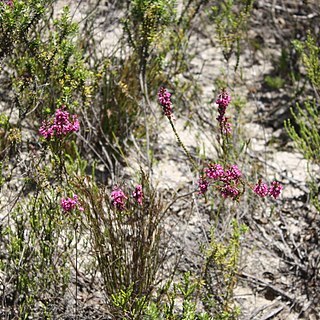Erect shrub up to 60 cm (2 ft) or so, usually less. Branches many, subvirgate or flexuous, pubescent. Leaves 3-nate, 2-4 m.n1 long, linear to ovate-oblong, erect, thick, sulcate, glabrous, imbricate or scarcely so. Flowers 1-to 3-nate in the leaf axils forming rather dense pseudo-racemes about 4-5 cm long, small; peduncles about 4 mm. long, pubescent; bracts remote, small Sepals 2 mm long, oblong, lanceolate or almost elliptical, keeled, very concave, scarious-edged, glabrous, ciliate. Corolla 3-4 mm long, rather narrow-urceolate to cyathiform, slightly narrowed at the mouth, subtetragonous, glabrous, rosy or dark red; lobes slightly spreading, the length of the tube, obtuse. Anthers included, 0.5 mm long, lateral, narrow ovate or suboblong, cells deeply partite, appendiculate; pore 1/2 the length of the cell; awns partly decurrent on the filaments, the free part varying in length and the whole about as long as the cells. Ovary turbinate, glabrous or sparsely puberulous; style included; stigma capitate.
Erect shrublet to 60 cm. Flowers small, urn-to cup-shaped, sometimes narrowly so, in spikes, pink to dark red.

